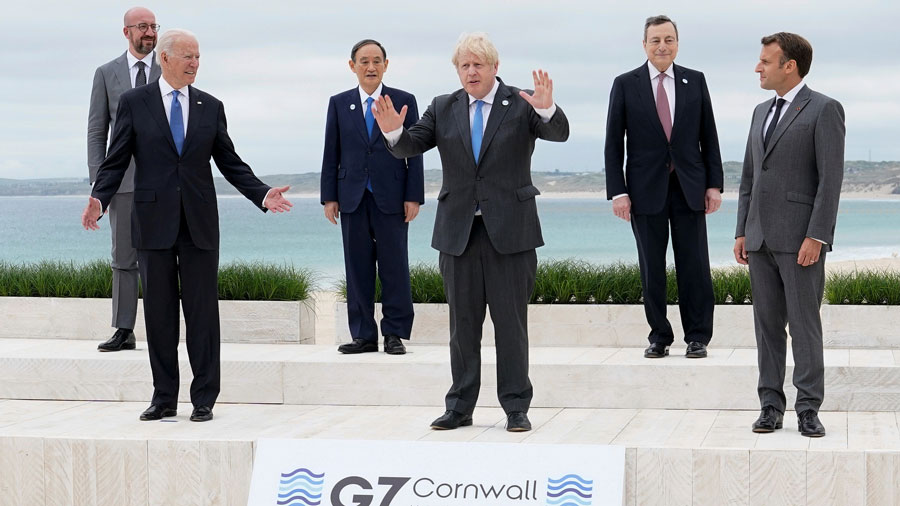Touted as a counter-response to China’s Belt and Road Initiative project, the G7, an inter-governmental political forum of the world’s wealthiest democracies comprising the United States of America, Japan, Germany, Britain, France, Italy and Canada launched the Build Back Better World initiative at the recent Cornwall summit. Proposed by the US president Joe Biden, it seeks to focus on providing “values-driven, high-standard, and transparent infrastructure partnership” to help narrow the $40 trillion needed by developing nations by 2035. However, there is no commitment on the modalities to mobilize resources to fund the projects under B3W.
The BRI is a multi-trillion dollar, politico-economic, transcontinental, long-term policy and investment project, which aims at infrastructural development and the economic integration of China with member countries. Apart from geopolitical ambitions, one crucial motivation for China to launch the BRI in 2013 was the domestic saturation of the infrastructure market; so much so that there were reports of Ghost Cities — constructed townships — lying vacant because of infrastructure surplus. This, however, is not the case with the G7 nations launching their B3W, particularly with the US that faces one of the worst infrastructure deficits of all time. The G7 is neither endowed with capital surplus nor is it a saturated domestic construction market like that of China.
The US’s ageing and dilapidated domestic infrastructure requires massive investments. According to the American Society of Civil Engineers, the US faces a $2.59 trillion infrastructure deficit that calls for massive government spending. The Biden administration had proposed a $2.25 trillion infrastructure plan to be spent over eight years, but it has been downsized to $1.7 trillion as per the latest estimates. The report by the ASCE also states that in the absence of significant infrastructural investments, the US economy would lose $10 trillion in growth, with exports declining by $2.4 trillion coupled with the loss of three million jobs domestically.
Construction has become China’s major export. Beijing possesses an enormous capital surplus, with its forex touching a record $1 trillion in May 2021. China has been the most resilient economy in the post-Covid world. It grew positively at 3.2 per cent during the pandemic as opposed to the G7 economies, which registered a sharp contraction in GDP varying from 9 to 21 per cent in the April-June quarter of 2020. According to the International Monetary Fund, unemployment in the G7 countries has risen, varying from 3.3 per cent to 11 per cent. According to the University of Southern California’s US-China Institute, Japan and the European Union members of the G7 collectively have greater trade ties with China than they do with the US. However, the trade equation between the EU and the US may ameliorate, subject to the relaxation of tariffs imposed by the Donald Trump administration. All these factors shall impact the nature and scope of the B3W project.
B3W differs from BRI. The former is a collective endeavour of seven countries with a democratic political system as opposed to BRI that is solely designed and executed by China that follows a one-party communist system. But the B3W is not without its infirmities. Given their trade and investment deals with Beijing, Germany, Italy and the EU may be hesitant to sever their ties with China. Second, the pandemic has adversely affected the growth of the G7 economies. Finally, regime changes in G7 countries due to their democratic political systems make the B3W a volatile project.
The BRI has had its fair share of criticisms due to allegations of corruption, lack of transparency and signs of malinvestments and corporate debt in the projects undertaken. However, a hurried, uncritical acceptance of the US-backed B3W as a panacea to the BRI would be undesirable. Moreover, pitching the G7’s B3W against China’s BRI may resurrect an ecosystem of two-bloc politics reminiscent of the Cold War.
India was invited, along with Australia, South Korea and South Africa, to the G7 summit. New Delhi’s response to the B3W was positive. However, India’s assessment must be based on to what extent does the B3W benefit New Delhi. Given India’s extensive economic ties with China and its political ties with the US, it would be challenging for India to decide whether it should adhere to and engage with a potential power bloc-based configuration or call for a revival of NAM 2.0 but not as a ritual performed every three years.










